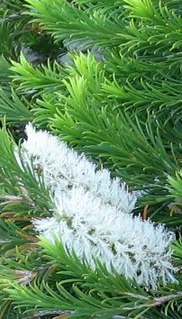
Melaleuca armillaris, commonly known as bracelet honey myrtle, is a plant in the myrtle family, Myrtaceae, and is native to South Australia, Victoria and Tasmania in south-eastern Australia. It is a hardy, commonly grown species, often used as a fast-growing screen plant, but it also has the potential to become a weed. It has become naturalised in Western Australia and parts of Victoria. In its natural state, it grows on coastal cliffs and along estuaries.

Melaleuca linariifolia is a plant in the myrtle family Myrtaceae, and is endemic to eastern Australia. It is commonly known as snow-in-summer, narrow-leaved paperbark, flax-leaved paperbark and in the language of the Gadigal people as budjur. A hardy plant, it flowers prolifically in late spring or summer, making it a popular garden shrub or small tree in temperate places. Melaleuca trichostachya is a similar species but its leaves are arranged differently and the fruits have projecting valves.
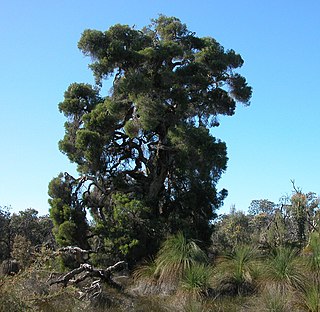
Melaleuca preissiana, commonly known as stout paperbark, modong or moonah, is a plant in the myrtle family, Myrtaceae and is endemic to coastal areas of southwest Australia. It is a shrub or small tree with papery bark, small leaves and spikes of usually white flowers. It occurs chiefly in areas that are seasonally wet.

Melaleuca viminalis, commonly known as weeping bottlebrush, or creek bottlebrush is a plant in the myrtle family, Myrtaceae and is endemic to New South Wales, Queensland and Western Australia. It is a multi-trunked, large shrub or tree with hard bark, often pendulous foliage and large numbers of bright red bottlebrush flowers in spring and summer. It is possibly the most commonly cultivated melaleuca in gardens and its cultivars are often grown in many countries.

Melaleuca viridiflora, commonly known as broad-leaved paperbark is a plant in the myrtle family, Myrtaceae and is native to woodlands, swamps and streams of monsoonal areas of northern Australia and New Guinea. It is usually a small tree with an open canopy, papery bark and spikes of cream, yellow, green or red flowers.
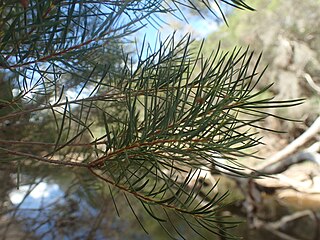
Melaleuca trichostachya is a plant in the myrtle family, Myrtaceae and is native to inland northern New South Wales, Queensland, South Australia and the Northern Territory in Australia. It is a small tree, similar to the commonly cultivated Melaleuca styphelioides, with its prickly foliage and fluffy spikes of white or cream flowers but there are differences in the leaf arrangement and fruiting capsules.

Melaleuca elliptica, commonly known as the granite bottlebrush is a plant in the myrtle family, Myrtaceae and is endemic to the south of Western Australia. The Noongar name for the plant is gnow. It is commonly grown in gardens because of its neat foliage and showy, bright red flower spikes although it needs to be pruned regularly to avoid becoming woody and untidy-looking. In nature, it usually grows in the shrub layer in mallee woodland or heath.

Melaleuca ericifolia, commonly known as swamp paperbark, is a plant in the myrtle family, Myrtaceae and the genus Melaleuca, native to south-eastern Australia. It is a rather variable species and some specimens resemble Melaleuca armillaris but its papery bark and smaller, more prolific flower heads distinguish it from that species. It often grows in swampy areas and the draining and clearing of these has reduced the numbers of the species, especially around Port Philip Bay near Melbourne. It is also similar to Melaleuca pustulata, a Tasmanian endemic, but that species only grows in dry heath.

Melaleuca strobophylla is a shrub or small tree in the myrtle family Myrtaceae and is endemic to the south-west of Western Australia. It has papery bark, sharply pointed, twisted leaves and rather long spikes of creamy white flowers in summer.

Melaleuca hypericifolia, commonly known as hillock bush, is a plant in the myrtle family, Myrtaceae, genus Melaleuca and is endemic to New South Wales in Australia. It has large, orange to red flower spikes and consequently is a commonly cultivated species. In 1797, James Edward Smith described the plant as:

Melaleuca nodosa, commonly known as the prickly-leaved paperbark, is a plant in the myrtle family, Myrtaceae and is endemic to eastern Australia. It is a shrub or small tree with narrow, sometimes needle-like leaves and profuse heads of yellow flowers as early as April or as late as January.
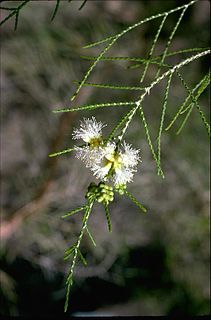
Melaleuca minutifolia, commonly known as teatree is a plant in the myrtle family, Myrtaceae and is endemic to northern Australia. As suggested by its name, it has tiny leaves but it also produces creamy white to white flowers throughout the year in its native range.

Melaleuca brevifolia, commonly known as mallee honey-myrtle, short-leaf honey-myrtle, or d'Alton's melaleuca is a shrub or tree in the myrtle family, Myrtaceae, and is native to western Victoria, south-eastern South Australia and the south-west of Western Australia. It is a shrub with rough, corky bark and a large number of heads of white to yellowish flowers on the previous season's growth. It is a moderately hardy garden plant.
Melaleuca arcana is a small tree or large shrub in the myrtle family, Myrtaceae and is endemic to Cape York Peninsula in northern Australia. It has papery bark and small heads of white flowers in summer.
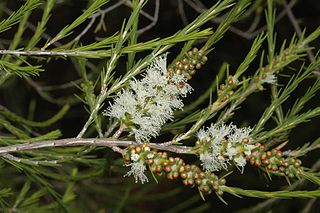
Melaleuca densispicata is a plant in the myrtle family Myrtaceae and is native to Queensland and New South Wales in Australia. It is a dense, woody shrub or tree with papery or scaly bark, sharp pointed leaves and dense flower spikes. It is uncommon throughout its range and was not formally described until 1984.
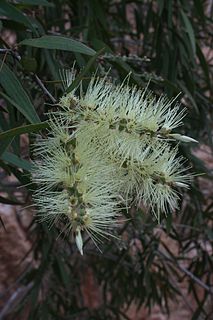
Melaleuca fluviatilis is a plant in the myrtle family, Myrtaceae and is endemic to northern Queensland in Australia. It is a tree with papery bark, narrow leaves and spikes of white or creamy-coloured flowers, usually growing along streams and rivers. It is common in tropical areas and is sometimes confused with Melaleuca argentea although it lacks that species' silvery foliage.

Melaleuca irbyana, commonly known as weeping paperbark, bushhouse paperbark and swamp paperbark, is a plant in the myrtle family Myrtaceae and is endemic to New South Wales and Queensland in Australia. It is a shrub or small tree, often growing in pure stands in poorly drained areas. Its distribution is limited and it has been classified as an endangered species under legislation in both states and the forest as critically endangered under Australian government legislation.

Melaleuca sieberi is a shrub or tree in the myrtle, family Myrtaceae, which is endemic to coastal areas of New South Wales and Queensland. It is a large shrub or small tree with papery bark on the trunk, small, sharp leaves and small heads of fluffy flowers in spring. It should not be confused with Callistemon sieberi. When the callistemons were moved to Melaleuca, Callistemon sieberi became Melaleuca paludicola.
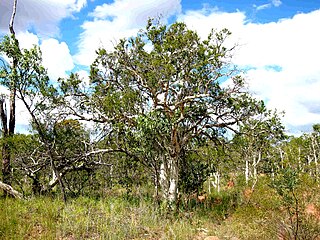
Melaleuca tamariscina, commonly known as bush-house paperbark or tamarix honey-myrtle is a plant in the myrtle family, Myrtaceae and is endemic to central Queensland in Australia. It grows to the height of a small tree with small, scale-like leaves that are pressed against the branches, and has a papery bark and a weeping habit.

Melaleuca salicina, commonly known as willow bottlebrush, is a plant in the myrtle family Myrtaceae, and is endemic to eastern Australia. Some Australian state herbaria continue to use the name Callistemon salignus, a name that is accepted by the Australian Plant Census. It is a shrub or small tree with soft foliage, pink new growth, white papery bark and spikes of usually white or creamy bottlebrush flowers in spring.


























